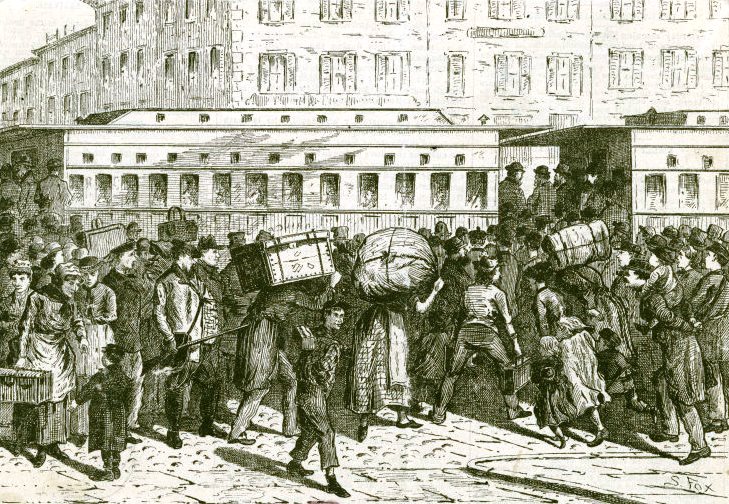 Cross-Link: Immigration Gateways and Ports of Entry
Cross-Link: Immigration Gateways and Ports of Entry
Immigration Summary
Among the Immigrants, Stanley Fox, 1850

- Census figures indicate that about 6 million Germans, 4.5 million Irish, 4.75 million Italians, 4.2 million people from England, Scotland and Wales, approximately the same number from the Austro-Hungarian Empire, 2.3 million Scandinavians, and 3.3 million people from Russia and the Baltic states entered the United States.
- Between the 1840s and the 1870s, Germans and Irish groups were predominant.
- Between 1854 and 1892 more Germans arrived in any given year than any other ethnic group, except for three years when the Irish predominated.
- Beginning in 1896 people from southern and eastern Europe, such as Italians, Jews, and Slavic peoples from the Austro-Hungarian Empire, were the most numerous groups.
- Click here for a summary of immigration before the civil war by the Constitutional Rights Foundation.. This source includes information about immigration as well as discussion questions and a classroom activity.
Industrialization in Europe caused the relocation of most immigrants.
- The transformation from small, agriculture-based societies to manufacturing economies was so rapid and sweeping that it became known as the Industrial Revolution.
- The Industrial Revolution began in England in the late 18th century and gradually spread across Europe. During the mid-19th century, the Industrial Revolution swept across France, Belgium, and the German states. In each of these areas the economic and social changes accompanying rapid industrialization led to a huge exodus of people.
- Although Ireland did not industrialize until the end of the 19th century, a severe famine in the 1830s and 1840s and the replacement of small farms by larger estates produced similar mass migrations of displaced people.
 Watch this video on the Great Famine for information on Irish Immigration before the Civil War
Watch this video on the Great Famine for information on Irish Immigration before the Civil War
- By the late 1870s, industrialization had pushed into Scandinavia, sending waves of Danish, Norwegian, and Swedish immigrants to the United States. Similarly, industrialization in southern and Eastern Europe during the 1880s and 1890s encouraged the mass migrations of Italians, Slavs, and Jews.
Although economic changes were the predominant factors prompting these movements, others left their homelands because of political upheavals, religious persecution, or in search of adventure. For example, about 4,000 Germans left their homes as a result of the political upheavals that swept through central Europe in 1848.
More Resources on Immigration

- Watch part one of two of Ellis Island--History of Immigration (1890-1920) here
- Watch a clip of PBS's Faces of America featuring Stephen Colbert, here
• Crash Course video on European Migration in 19th Century, here
- When America despised the Irish (History Channel Documents)

For a lesson plan on European immigration, click here
Comments (0)
You don't have permission to comment on this page.